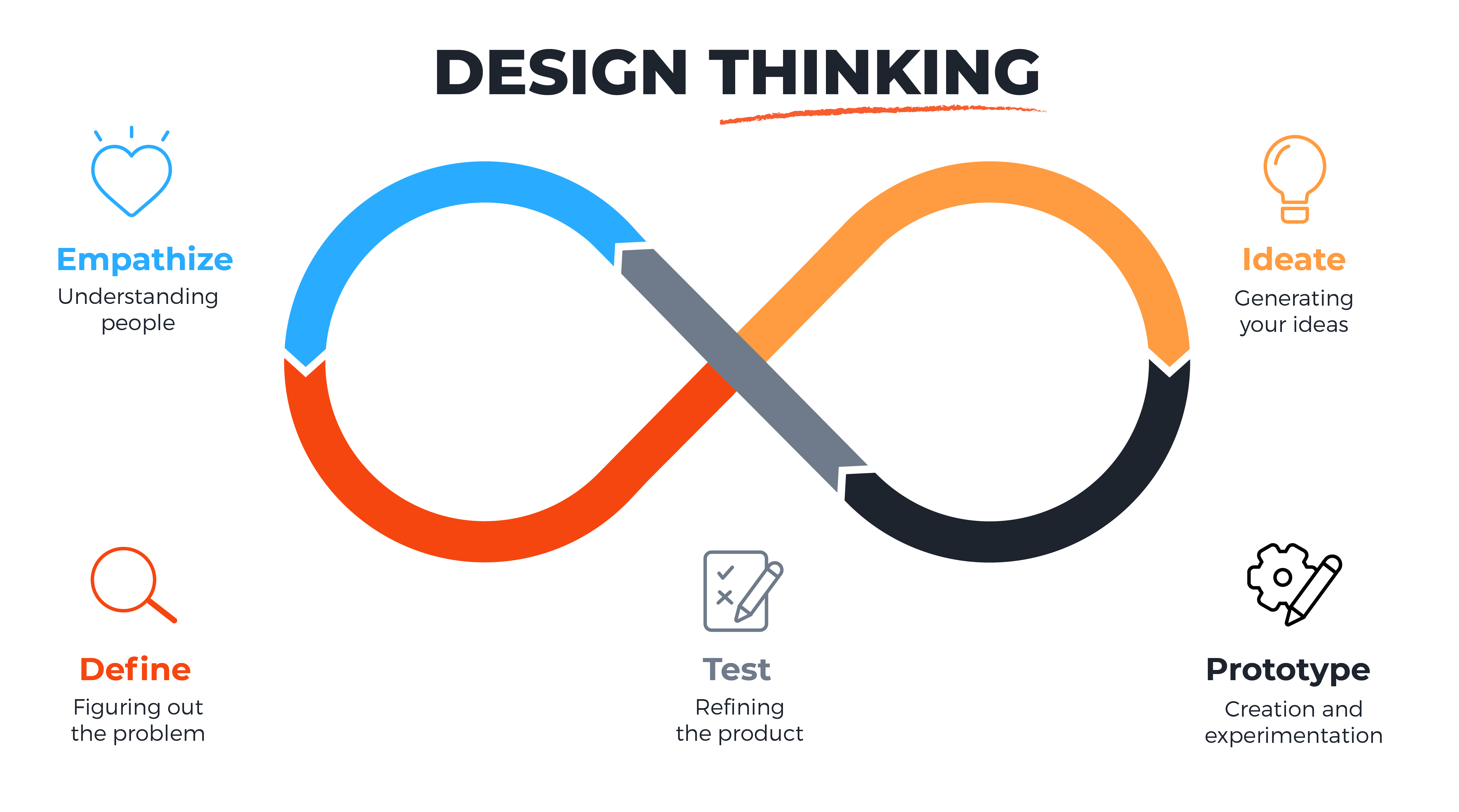
Organizations seeking to build business agility often talk about something called “design thinking”. We use design thinking at MAQE in every project. You can see it in action in our work with Chanintr. Design Thinking informs how we work and how our teams are structured.
If you’re not sure what design thinking is but you’ve heard about it, this post will go into some detail about design thinking and how you can use it as a human-centric approach to problem solving.
What is design thinking?
Design thinking is an iterative, non-linear way of working that seeks to understand users and solve problems. It consists of five phases-empathize, define, ideate, prototype and test. The process is perfect for situations where the overall challenge is not clear or you have problems that are as yet unknown.
With rapid technological, environmental and social change becoming the new normal, it’s important for companies to be as agile as possible. Design thinking is a human-centric approach that can help to deal with this environment of constant change. It allows designers to focus on what’s best for the user.
The 5 phases of design thinking
There are 5 phases of design thinking, but it’s important to note that they aren’t sequential steps. So you don’t start in phase 1 and work through them all the way to phase 5 where you reach a conclusion. But you do return to earlier phases at regular intervals throughout your journey.

Empathize – Understanding people
Empathy is vital to the design thinking process. It allows designers to step outside their own biases to figure out exactly what the user wants.
Designers and developers can gain empathy by consulting with experts who can help to provide an insight into the overall problem. By liaising with people who actually deal with problems on a day-to-day basis, designers understand their motivations and experiences. Ultimately this means that they can help to create a solution to the problem that helps everyone. Which can include internal teams or the end-user or even both.
To build solutions and environments that are human-centric, you need real empathy. Taking time in this phase can gather actionable insights and give you the best possible understanding of the needs that need to be resolved by a new product or service.

Define – Figuring out the problem
During the define phase, you put together the information you gathered during the empathize phase.
Once you have collected all the information and observations that you and your team may have gathered, it’s time for some analysis to help you define the core problem.
But it’s important to remember that you should keep thinking about the problem in human-centric terms. By using the findings from the empathize phase, you should be able to define the problem in a way that keeps people at the center of the solution.
If you’re using a design thinking approach, you wouldn’t define the problem in terms that could highlight a company objective. A statement like “the company needs to increase conversion and lifetime value per user” is not thinking about the problem in a human-centric way. However, if you define the problem in terms of the user, addressing their needs, then a problem statement such as “customers need their goods delivered quickly” would be consistent with a design thinking approach.

Ideate – Generating your ideas
You and your team should now understand the needs of your users, taken from your discoveries in the empathize phase. You should also have isolated the problem in a human-centric way and generated a problem statement
Now, at this phase of the design thinking journey, you and your team can begin to generate ideas.
There are various ways you can ideate and a lot of techniques you can use. But you should try to gather as many ideas and solutions as you can. You can even experiment with your ideation techniques. For example, you could use the SCAMPER technique initially and then switch to the “worst possible idea” technique to see if you can test your ideas rigorously before moving to the prototype phase.

Prototype – Creation and experimentation
During the prototyping phase, a number of scaled-down versions of the product are created. These prototypes may focus on specific features of the product which try to solve the problems identified in the empathize, define and ideate phases.
Prototyping thoroughly can help to better address the user needs and problems identified. A number of features may be put in place one after the other so each can be assessed. If they do not properly resolve issues and needs then they can be rejected.
By testing all these different features your team will start to get a better idea of the kind of constraints they may be dealing with and how well their ideas are resolving user issues.

Test – Refining the product
In this phase, your team will rigorously test the product using the findings and solutions that were discovered in the prototyping phase.
Although this is the final stage of design thinking, it is important to note that this is not where it ends. As the design thinking process is iterative, the results generated from testing can often cause some redefinition of the problems you are trying to solve for the user. This means that you can often go back and revisit the other design thinking phases so you can refine the product so it is as effective as it can be.
Extensive testing can really help you to develop an even deeper understanding of your product and your users. So going backwards to other phases should not be seen as a failure.
Thinking differently
Although a process with 5 stages can seem linear, it really is not. Design thinking means that different teams can be working on different phases all at the same time. Teams need to retain agility and flexibility for design thinking to deliver the best results.
This means that you may need to think about how your teams are structured so they can work effectively together in a design thinking process. Controlled, top-down organizational structures do not tend to lend themselves towards a design thinking approach. Your teams need to work loosely, but aligned with real autonomy so they can follow the process to produce human-centric outcomes.
Design thinking should bring your ideas to life by putting users at the center of every process.
Takeaways
- Empathy – Try to connect with the user’s needs
- Define – Use your findings to generate a human-centric problem statement
- Ideate – Gather as many ideas as you can
- Prototype – Stay focused on user needs. Even if you like a feature, if it doesn’t help the user it’s not necessary
- Test – Going backwards really can mean you are going forwards

How MAQE can help you
We’ve used design thinking in our work for a long time now. So we have a lot of knowledge that we can give you on your project. We offer consultation on digital transformation and organizational design that can really help your business to implement a design thinking approach.
Get in touch with us via [email protected] so we can have a coffee and chat about your needs.
